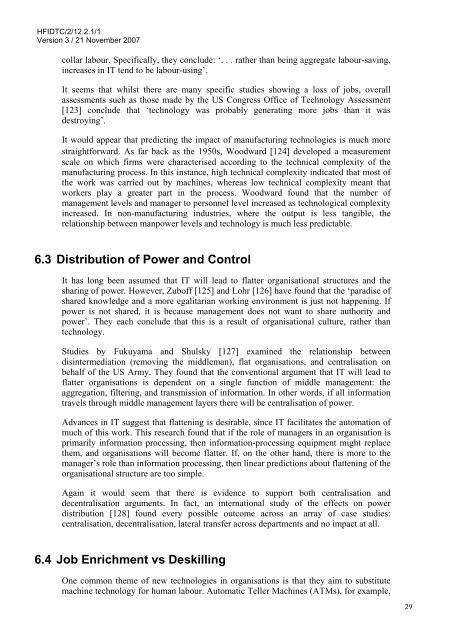The Impact of Technology Insertion on Organisations
The Impact of Technology Insertion on Organisations
The Impact of Technology Insertion on Organisations
Create successful ePaper yourself
Turn your PDF publications into a flip-book with our unique Google optimized e-Paper software.
HFIDTC/2/12.2.1/1<br />
Versi<strong>on</strong> 3 / 21 November 2007<br />
collar labour. Specifically, they c<strong>on</strong>clude: ‘. . . rather than being aggregate labour-saving,<br />
increases in IT tend to be labour-using’.<br />
It seems that whilst there are many specific studies showing a loss <str<strong>on</strong>g>of</str<strong>on</strong>g> jobs, overall<br />
assessments such as those made by the US C<strong>on</strong>gress Office <str<strong>on</strong>g>of</str<strong>on</strong>g> <str<strong>on</strong>g>Technology</str<strong>on</strong>g> Assessment<br />
[123] c<strong>on</strong>clude that ‘technology was probably generating more jobs than it was<br />
destroying’.<br />
It would appear that predicting the impact <str<strong>on</strong>g>of</str<strong>on</strong>g> manufacturing technologies is much more<br />
straightforward. As far back as the 1950s, Woodward [124] developed a measurement<br />
scale <strong>on</strong> which firms were characterised according to the technical complexity <str<strong>on</strong>g>of</str<strong>on</strong>g> the<br />
manufacturing process. In this instance, high technical complexity indicated that most <str<strong>on</strong>g>of</str<strong>on</strong>g><br />
the work was carried out by machines, whereas low technical complexity meant that<br />
workers play a greater part in the process. Woodward found that the number <str<strong>on</strong>g>of</str<strong>on</strong>g><br />
management levels and manager to pers<strong>on</strong>nel level increased as technological complexity<br />
increased. In n<strong>on</strong>-manufacturing industries, where the output is less tangible, the<br />
relati<strong>on</strong>ship between manpower levels and technology is much less predictable.<br />
6.3 Distributi<strong>on</strong> <str<strong>on</strong>g>of</str<strong>on</strong>g> Power and C<strong>on</strong>trol<br />
It has l<strong>on</strong>g been assumed that IT will lead to flatter organisati<strong>on</strong>al structures and the<br />
sharing <str<strong>on</strong>g>of</str<strong>on</strong>g> power. However, Zub<str<strong>on</strong>g>of</str<strong>on</strong>g>f [125] and Lohr [126] have found that the ‘paradise <str<strong>on</strong>g>of</str<strong>on</strong>g><br />
shared knowledge and a more egalitarian working envir<strong>on</strong>ment is just not happening. If<br />
power is not shared, it is because management does not want to share authority and<br />
power’. <str<strong>on</strong>g>The</str<strong>on</strong>g>y each c<strong>on</strong>clude that this is a result <str<strong>on</strong>g>of</str<strong>on</strong>g> organisati<strong>on</strong>al culture, rather than<br />
technology.<br />
Studies by Fukuyama and Shulsky [127] examined the relati<strong>on</strong>ship between<br />
disintermediati<strong>on</strong> (removing the middleman), flat organisati<strong>on</strong>s, and centralisati<strong>on</strong> <strong>on</strong><br />
behalf <str<strong>on</strong>g>of</str<strong>on</strong>g> the US Army. <str<strong>on</strong>g>The</str<strong>on</strong>g>y found that the c<strong>on</strong>venti<strong>on</strong>al argument that IT will lead to<br />
flatter organisati<strong>on</strong>s is dependent <strong>on</strong> a single functi<strong>on</strong> <str<strong>on</strong>g>of</str<strong>on</strong>g> middle management: the<br />
aggregati<strong>on</strong>, filtering, and transmissi<strong>on</strong> <str<strong>on</strong>g>of</str<strong>on</strong>g> informati<strong>on</strong>. In other words, if all informati<strong>on</strong><br />
travels through middle management layers there will be centralisati<strong>on</strong> <str<strong>on</strong>g>of</str<strong>on</strong>g> power.<br />
Advances in IT suggest that flattening is desirable, since IT facilitates the automati<strong>on</strong> <str<strong>on</strong>g>of</str<strong>on</strong>g><br />
much <str<strong>on</strong>g>of</str<strong>on</strong>g> this work. This research found that if the role <str<strong>on</strong>g>of</str<strong>on</strong>g> managers in an organisati<strong>on</strong> is<br />
primarily informati<strong>on</strong> processing, then informati<strong>on</strong>-processing equipment might replace<br />
them, and organisati<strong>on</strong>s will become flatter. If, <strong>on</strong> the other hand, there is more to the<br />
manager’s role than informati<strong>on</strong> processing, then linear predicti<strong>on</strong>s about flattening <str<strong>on</strong>g>of</str<strong>on</strong>g> the<br />
organisati<strong>on</strong>al structure are too simple.<br />
Again it would seem that there is evidence to support both centralisati<strong>on</strong> and<br />
decentralisati<strong>on</strong> arguments. In fact, an internati<strong>on</strong>al study <str<strong>on</strong>g>of</str<strong>on</strong>g> the effects <strong>on</strong> power<br />
distributi<strong>on</strong> [128] found every possible outcome across an array <str<strong>on</strong>g>of</str<strong>on</strong>g> case studies:<br />
centralisati<strong>on</strong>, decentralisati<strong>on</strong>, lateral transfer across departments and no impact at all.<br />
6.4 Job Enrichment vs Deskilling<br />
One comm<strong>on</strong> theme <str<strong>on</strong>g>of</str<strong>on</strong>g> new technologies in organisati<strong>on</strong>s is that they aim to substitute<br />
machine technology for human labour. Automatic Teller Machines (ATMs), for example,<br />
29

















